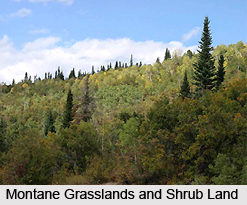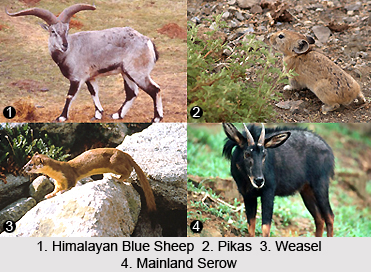 The montane grasslands and shrub-lands in India, is defined as a biome by the World Wildlife Fund (WWF). The high altitude grasslands and shrub-lands like montane, sub-alpine, and alpine are included in this biome. These grasslands and shrub-lands are mainly located above the tree line and are commonly known as alpine tundra. The alpine tundra occurs in the mountain regions around the world. The sub-alpine and montane grasslands and shrub-lands are located below the tree line. The stunted sub-alpine forests are commonly known as krummholz, and they occur just below the tree line. The harsh, windy conditions and poor soils create dwarfed and twisted forests of slow-growing trees, in these forests.
The montane grasslands and shrub-lands in India, is defined as a biome by the World Wildlife Fund (WWF). The high altitude grasslands and shrub-lands like montane, sub-alpine, and alpine are included in this biome. These grasslands and shrub-lands are mainly located above the tree line and are commonly known as alpine tundra. The alpine tundra occurs in the mountain regions around the world. The sub-alpine and montane grasslands and shrub-lands are located below the tree line. The stunted sub-alpine forests are commonly known as krummholz, and they occur just below the tree line. The harsh, windy conditions and poor soils create dwarfed and twisted forests of slow-growing trees, in these forests.
The montane grasslands and shrub-lands in India often evolved as virtual islands, particularly in subtropical and tropical regions, separated from other montane regions by warmer, lower elevation regions. They are frequently home to many distinctive and endemic plants that evolved in response to the cool, wet climate and abundant tropical sunlight. The characteristic plants of these habitats usually display adaptations like rosette structures, waxy surfaces, and hairy leaves. The presence of giant rosette plants from a variety of plant families like Lobelia, Puya, Cyathea, and Argyroxiphium, is a unique feature of many wet tropical montane regions.
The montane grasslands and shrub-lands in India are mainly found in the eco regions like the eastern Himalayas alpine shrub and meadows and the western Himalayas alpine shrub and meadows. The Eastern Himalayan alpine shrub and meadows, lies between the tree line and snow line in the eastern portion of the Himalaya Range. This ecoregion covers an area of 70,200 square kilometers, and extends along the north and south faces of the Himalaya Range. The Indian states of Sikkim, Arunachal Pradesh are included in this ecoregion. The alpine shrub and meadows usually lie between approximately 4000 and 5500 meters elevation, and permanent ice and snow lies above 5500 meters. The flora of the alpine shrub-lands are characterised by rhododendrons, which are predominate at lower elevations, close to the tree line. On the other hand, the alpine meadows support a variety of herbaceous plants, above the shrub lands. These plants include the species like Alchemilla, Androsace, Anemone, Diapensia, Draba, Gentiana, Impatiens, Leontopodium, Meconopsis, Pedicularis, Potentilla, Primula, Rhododendron, Saussurea, Saxifraga, Sedum, and Viola etc.
 The Western Himalayan alpine shrub and meadows is another alpine ecoregion, where the montane grasslands and shrub-lands in India are found. The ecoregion lies between the tree line and snow line in the western portion of the Himalaya Range. It covers an area of 70,200 square kilometers and is located across Uttarakhand and the eastern Himachal Pradesh states of India. The alpine shrub and meadows usually lie between approximately 3000 and 5000 meters elevation. The flora of these alpine shrub-lands is also dominated by rhododendrons that are predominating at lower elevations close to the tree line. The alpine meadows known as bugyals or bughiyals can be found above the shrub-lands. These support several herbaceous plants, including the species like Anaphalis, Cynanthus, Jurinea, Morina, Potentilla, Gentiana, Delphinium, Meconopsis, Pedicularis, Anemone, Aster, Polygonum, Primula, and Saussurea etc. The fauna of the montane grasslands and shrub-lands in India, in the Western Himalayan alpine shrub and meadows, include the large mammals like Snow Leopard, Bharal or Himalayan Blue Sheep, Himalayan Tahr, Himalayan Musk Deer, and Mainland Serow. Apart from these, some smaller mammals like Weasels and Pikas, are also found here.
The Western Himalayan alpine shrub and meadows is another alpine ecoregion, where the montane grasslands and shrub-lands in India are found. The ecoregion lies between the tree line and snow line in the western portion of the Himalaya Range. It covers an area of 70,200 square kilometers and is located across Uttarakhand and the eastern Himachal Pradesh states of India. The alpine shrub and meadows usually lie between approximately 3000 and 5000 meters elevation. The flora of these alpine shrub-lands is also dominated by rhododendrons that are predominating at lower elevations close to the tree line. The alpine meadows known as bugyals or bughiyals can be found above the shrub-lands. These support several herbaceous plants, including the species like Anaphalis, Cynanthus, Jurinea, Morina, Potentilla, Gentiana, Delphinium, Meconopsis, Pedicularis, Anemone, Aster, Polygonum, Primula, and Saussurea etc. The fauna of the montane grasslands and shrub-lands in India, in the Western Himalayan alpine shrub and meadows, include the large mammals like Snow Leopard, Bharal or Himalayan Blue Sheep, Himalayan Tahr, Himalayan Musk Deer, and Mainland Serow. Apart from these, some smaller mammals like Weasels and Pikas, are also found here.















